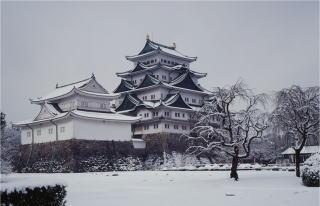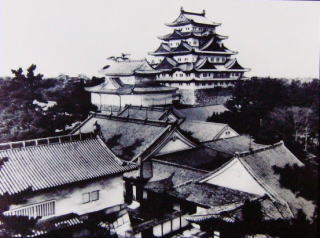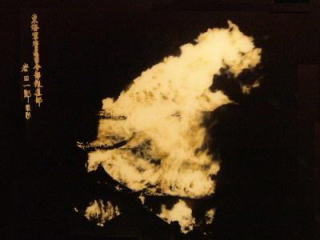 |
 |
Nagoya Castle
 |
 |
Nagoya Castle is the symbol of Nagoya.
The original castle was built in 1612 by Tokugawa Ieyasu (Shogun) for Yoshinao,
his 9th child, but it was burned down during World War II (May 14th 1945),
so the existing donjon was rebuilt in 1959 in honor of the 70th anniversary
of the city.
 |
 |
| Nagoya Castle was one of the three great castles in Japan with Kumamoto Castle and Himeji Castle, and designated as a national treasure. (Pic: copy from a poster in the castle) |
Burning Nagoya Castle May 14, 1945 (pic: copy from a poster in the castle) |
The original castle was a great one and was constructed using the top technology
of the time.
IEYASU put the Saigoku-Daimyos (daimyo means feudal lord), those who had
relations
with the TOYOTOMI family, in charge of building the castle.
This proved to be a very effective strategy
to reduce the financial and military power of the Saigoku-Daimyos.
The castle was built to defend against expected attacks from the Toyotomi
family,
but the family was killed in 1615 in the battle of Osaka-natsunojin,
allowing the great castle to stand for more than 300 years.
Obtaining large and good stones for the stone walls was difficult and hard
work.
Some stones were carried from the Kyushu area, very far from Nagoya.
If you look closely at the stone walls, you will see markings on the stones.
These show the possessor of the stones.
Ieyasu would always watch for a chance to reduce the power of the Saigoku-Daimyo.
He called for a complicated method of construction and declared that
if any of the Saigoku-Daimyos disrupted the building process, they would
receive a punishment.
This led to the Saigoku-Daimyo and his followers to begin carving marks
on the stones as a self-defense strategy.
| 刻紋 (kokumon) | |||||||||
| - | - | - | |||||||
| There are approx. 500 kinds of marks I think finding marks will make you feel like beeing Sherlock Holmes. Find more marks !
|
|||||||||
The symbol of Nagoya Castle is "Kin no Shachihoko", a pair of gold Shachihoko,
which look like killer whales.
They were crafted not only to show off the power of Ieyasu,
but also took a role of war funds in an emergency.
| "Kin no Shachihoko" covered with 18-carat scales | ||
| Male (North) 2.621m/ 1.272kg (18-carat: 44.69kg)/ 112 scales |
View from north-west (If you enter from the East gate[Shiyakusho subway station side], these three pictures are taken from the rear of the castle) |
Female (South) 2.579m /1.215kg (18 kcarat: 43.39kg)/ 126 scales |
Shachihoko is an imaginary animal which has a face like a tiger and a body
like fish.
The shachihoko is modeled after a real killer whale
It is said that as soon as they find fire, they belch out water immediately.
This was a charm to protect the buildings from fire.
You will find a pair of shachihoko on the rooftops of many castles or temples
in Japan
The style of putting the shachihoko on top of buildings started in the
early Muromachi Era
when Japanese castles first began to take form.
The core of the shachihoko was made of wood,
which was then plated with lead, followed by copper.
The shachihoko was then covered in large-sized as well as thin,
ovalic gold coins of the time.
The larger of these gold coins were very thick and had
a very high purity level (about 80%).
The shachihokos on Nagoya Castle glistened in the sun,
and word of them quickly spread among the people.
However in 1726, 1827, and 1846, when the domain of Owari experiencing
financial difficulties,
the Owari government removed the shachihoko scales and recasted them.
The quality of the gold quickly diminished and the shachihoko scales lost
their luster.
In addition, the government covered the shachihokos with wire netting
in order to protect them from big water birds named 'kou' in Japanese
(these wire nets made for a funny story later).
A legend said that the 'kou' brings a dead twig aflame.
The 'kou' once made a nest and put the fin to good use.
People didn't know the real meaning why the shachihokos were covered with
a wire net.
Many people guessed that it is the protection against a thief.
At that time, there was a habitual thief named Kakinoki Kinsuke.
He was caught and received the death penalty, but was granted a stay
because of a special festival and exiled instead.
Afterwards, he still continued his work and was arrested again,
but lucky for him, a large typhoon came and he took advantage of the confusion
to make his escape. But at last, he was arrested again and was crucified.
After his death, his head was hung at a prison gate as a deterrent.
People said that he stole the scales of the golden shachihoko by using
a very large kite,
but there is no documented proof.
In 1937, a real phantom thief appeared.
He used a scaffold which the Nagoya City government had produced
for making a measured drawing.
He stole 58 of the 112 scales from the male shachihoko (on the north side).
It was big news, but the city government put pressure
on mass communication not to write about the affair.
Complying with this, the press instead printed photos
of the donjon or of the donjon without the shachihokos*.
After viewing these pictures, some people suspected
that something bad had happened at Nagoya Castle.
The city mayor was very perplexed as the shachihoko was
part of a national treasure that Nagoya city had just received
from the Imperial Household Agency in 1930.
While the goverment was in confusion,
the thief casted the scales into gold ingots and sold them to many marchants.
However, he was arrested a month following the incident.
* These pictures were taken during a period after 1870,
when the shachihokos were taken down
in order to show them in expositions in many places.
Once, the shachihokos traveled overseas and were displayed
in the world exposition in Vienna
******
Nagoya Castle was built at the north edge of the Nagoya diluvial tableland,
natural fortfication.
Nagoya is roughly devided into three configurations. |
|
*******
| Observatory |
You can enjoy 360-degree panoramic views and buy very Nagoyan souvenirs
|
||||||||
| 5F |
You can take photos with a full-scale model shachihoko. You can also try to pull a stone for stone walls.
|
||||||||
| 4F |
Display of armors, weapons, etc.
|
||||||||
| 3F |
You can feel the life of the lord and the commonalty in the Edo period.
|
||||||||
| 2F | Special exhibition |
|
|||||||
| 1F |
|
||||||||
| B1 |
<= Well in a restored condition
|
| Spring | Omotenashi-Bushotai performance at Ninomaru-Hiroba map |
*******
| Address: | 1-1 Honmaru Naka-ku Nagoya |
||
| TEL | (052)231-1700 | ||
| Hours | 9:00-16:30(During Sakura Festival and Summer Festival extended till 21:00) | ||
| Closed | Dec.29-Jan.1 | ||
| Admission | 500 yen (Under15 |
||
| Access |
|
Get off at SHIYAKUSHO on the MEIJO Subway Line, go through exit No.7 5 minutes walk |
|
| |
栄13 (Sakae 13), 栄27 (Sakae 27), 西巡回(Nishi-Junkai) メーグル(Meguru sightseeing route bus) |
||
|
map |
|||
| Hachimaru Official mascot character of Nagoya Castle |
Free Guided Tour of Nagoya Castle
*English speaking guide
*Every Sunday
*Meet at 13:30 at East Gate (Higashi-Mon 東門) of Nagoya Castle
*Entrance fee(500yen) is required
*No reservation required
現存する本丸御殿:川越城、高知城
二条城、掛川城
![]()